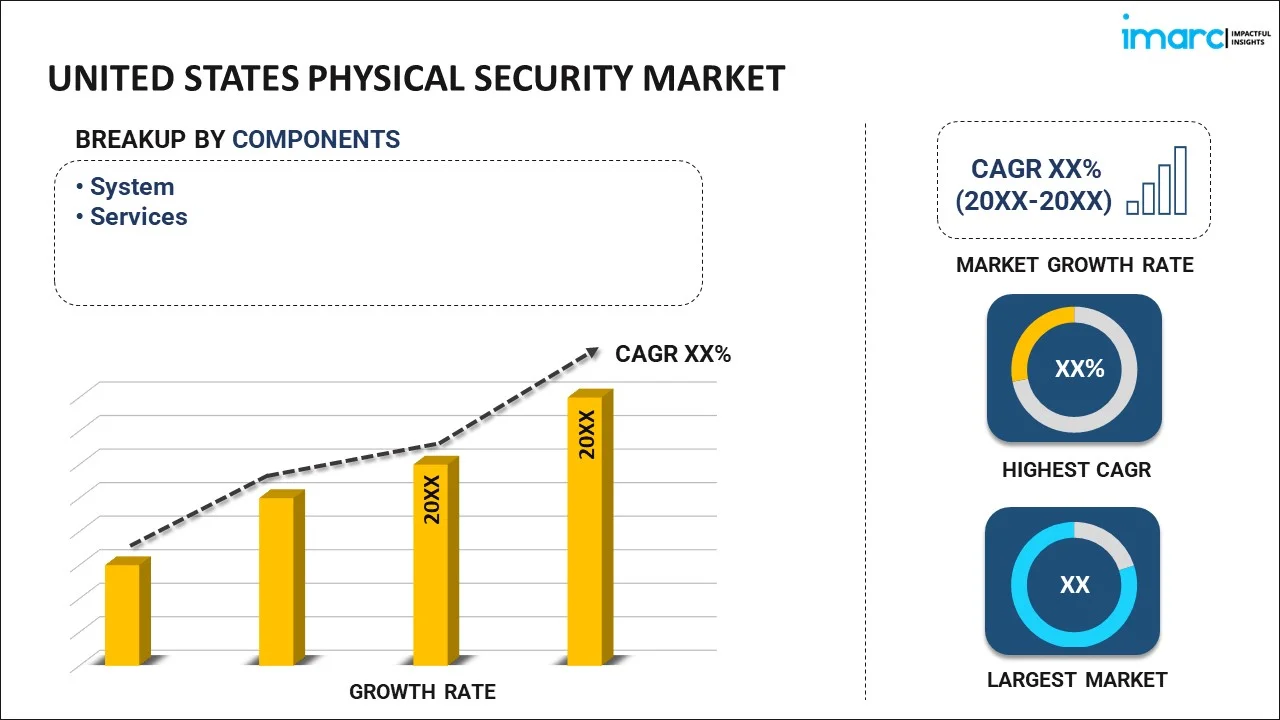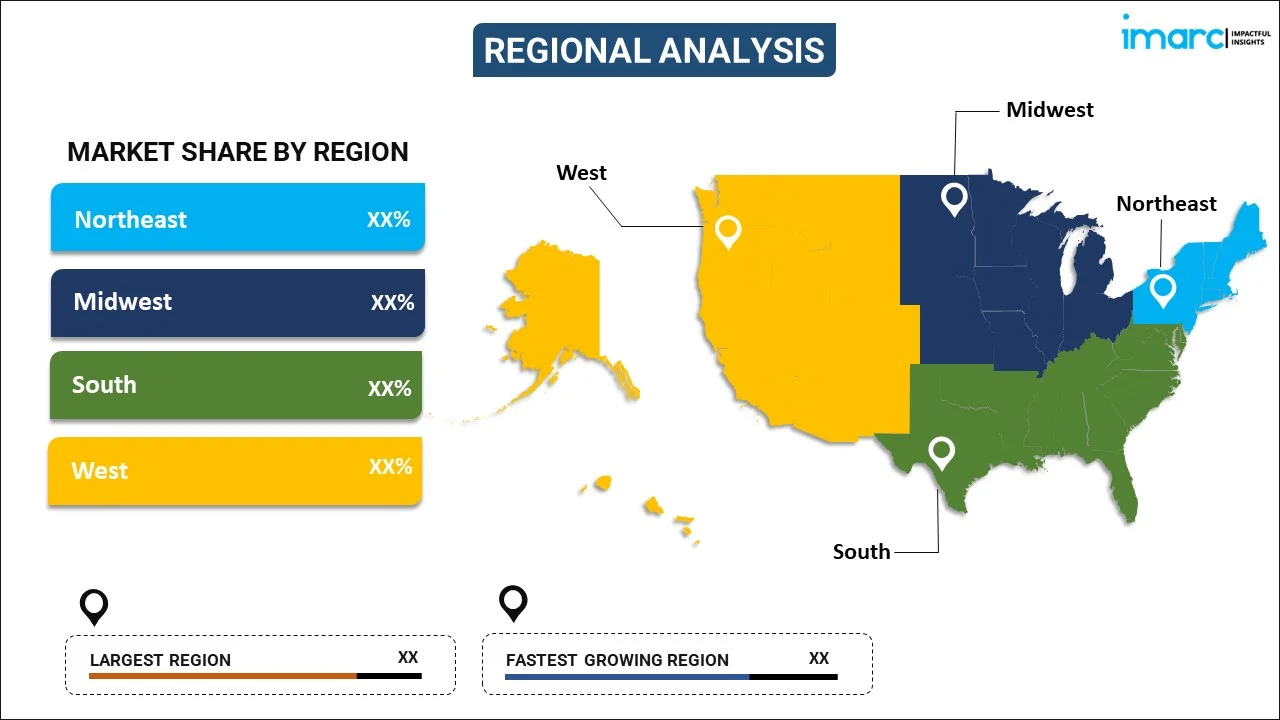
United States Physical Security Market Report by Component (System, Services), Enterprise Size (Large Enterprises, Small and Medium-sized Enterprises), Industry Vertical (Retail, Transportation, Residential, IT and Telecom, BFSI, Government, and Others), and Region 2025-2033
Market Overview:
United States physical security market size reached USD 30.7 Billion in 2024. Looking forward, IMARC Group expects the market to reach USD 45.6 Billion by 2033, exhibiting a growth rate (CAGR) of 4.5% during 2025-2033. The rising adoption of smart city initiatives and the integration of the Internet of Things (IoT) in security systems are primarily driving the United States physical security market share across the country.
|
Report Attribute
|
Key Statistics
|
|---|---|
|
Base Year
|
2024 |
|
Forecast Years
|
2025-2033
|
|
Historical Years
|
2019-2024
|
| Market Size in 2024 | USD 30.7 Billion |
| Market Forecast in 2033 | USD 45.6 Billion |
| Market Growth Rate (2025-2033) | 4.5% |
United States Physical Security Market Analysis:
- Key Market Trends: AI-powered surveillance, cloud-based access control, and touchless biometrics are reshaping physical security. Integration with Internet of Things (IoT) and mobile platforms is driving smarter, more proactive threat management systems thus strengthening the United States physical security market demand.
- Major Drivers: Rising security threats, urbanization, remote workforce expansion, and regulatory compliance demands are pushing businesses to modernize physical security infrastructure with scalable, data-driven, and contactless solutions.
- Market Opportunities: High growth potential exists in sectors like healthcare, smart cities, and education for cloud-based security, AI analytics, and subscription-based Security-as-a-Service (SECaaS), offering recurring revenue models and rapid deployment.
- Market Challenges: Privacy concerns, high initial integration costs, cybersecurity vulnerabilities, and interoperability with legacy systems pose barriers to adopting next-gen physical security technologies across diverse organizational environments.
Physical security is a crucial measure aimed at safeguarding various elements such as tangible assets, personnel, software, hardware, networks, and property from potential physical threats or actions that could lead to significant loss or damage. These threats encompass a range of scenarios, including natural disasters, burglary, fire, floods, robbery, vandalism, terrorism, and theft. The implementation of physical security involves a multi-layered approach, utilizing interconnected systems like perimeter intrusion detection, access control, security systems, locks, deterrent systems, fire protection, CCTV surveillance, and the presence of security guards. By employing these measures, physical security plays a key role in monitoring and identifying security breaches, preventing unauthorized access to facilities, and fostering trust and confidence. Consequently, the application of physical security is widespread in various industries such as transportation, retail, information technology (IT), telecommunications, and the banking, financial services, and insurance (BFSI) sectors.
United States Physical Security Market Trends:
Integration of AI and Video Analytics in Surveillance Systems
Artificial intelligence (AI) and advanced video analytics are transforming traditional surveillance systems across the U.S. physical security market. AI-enabled cameras can now detect unusual behavior, recognize faces, read license plates, and identify objects in real time. These systems help reduce human error, minimize false alarms, and streamline incident responses. Retailers, airports, and city governments increasingly use smart surveillance to enhance safety and operational efficiency. Cloud-based platforms allow security personnel to access video feeds remotely, improving response times. Moreover, predictive analytics powered by machine learning helps in threat detection before incidents occur. The integration of AI also supports compliance with privacy and data protection regulations by enabling selective masking and anonymization. As threats evolve, businesses are prioritizing smart surveillance as a proactive security measure, making AI-driven solutions a core trend in physical security upgrades.
Rise of Access Control and Touchless Technologies
The demand for advanced access control and touchless security technologies has surged the United States physical security market growth, accelerated by health concerns from the COVID-19 pandemic. Organizations are replacing traditional keycards and PIN-based systems with biometric authentication (facial recognition, iris scan, or fingerprint) and mobile-based access. These technologies enhance hygiene, reduce unauthorized entry risks, and offer more precise tracking of personnel movement. Cloud-based access control systems are gaining popularity for their scalability, remote management, and integration with HR and visitor management platforms. In corporate offices, hospitals, and educational institutions, touchless systems also contribute to building energy efficiency by linking with lighting and HVAC controls. Compliance with data privacy laws is driving innovation in secure data encryption and user consent frameworks. The shift toward frictionless, secure, and health-conscious access solutions marks a long-term trend in modernizing physical security infrastructure.
Growth of Security-as-a-Service (SECaaS) Models
Security-as-a-Service (SECaaS) is becoming a major United States physical security market trends as businesses seek flexible, cost-effective, and scalable security solutions. This model offers physical security infrastructure—such as surveillance, access control, and alarm systems—through cloud-managed platforms with subscription-based pricing. Instead of large upfront capital expenditures, organizations can opt for ongoing service agreements that include system updates, maintenance, and technical support. Managed services allow integration with cybersecurity tools, bridging the gap between physical and digital security. Small and medium-sized enterprises (SMEs) especially benefit from this trend due to limited IT and security budgets. Providers often include AI features, analytics dashboards, and mobile management apps, making security operations more efficient and accessible. As digital transformation accelerates and hybrid work models persist, SECaaS offers the agility and innovation that organizations need to stay protected without heavy infrastructure investments.
United States Physical Security Market Segmentation:
IMARC Group provides an analysis of the key trends in each segment of the market, along with forecasts at the country level for 2025-2033. Our report has categorized the market based on component, enterprise size, and industry vertical.
Component Insights:

To get more information on this market, Request Sample
- System
- Physical Access System
- Video Surveillance System
- Perimeter Intrusion and Detection
- Physical Security Information Management
- Others
- Services
- System Integration
- Remote Monitoring
- Others
The report has provided a detailed breakup and analysis of the market based on the component. This includes system (physical access system, video surveillance system, perimeter intrusion and detection, physical security information management, and others) and services (system integration, remote monitoring, and others).
Enterprise Size Insights:
- Large Enterprises
- Small and Medium-sized Enterprises
A detailed breakup and analysis of the market based on the enterprise size have also been provided in the report. This includes large enterprises and small and medium-sized enterprises.
Industry Vertical Insights:
- Retail
- Transportation
- Residential
- IT and Telecom
- BFSI
- Government
- Others
The report has provided a detailed breakup and analysis of the market based on the industry vertical. This includes retail, transportation, residential, IT and telecom, BFSI, government, and others.
Regional Insights:

- Northeast
- Midwest
- South
- West
The report has also provided a comprehensive analysis of all the major regional markets, which include Northeast, Midwest, South, and West.
Competitive Landscape:
The market research report has also provided a comprehensive analysis of the competitive landscape. Competitive analysis such as market structure, key player positioning, top winning strategies, competitive dashboard, and company evaluation quadrant has been covered in the report. Also, detailed profiles of all major companies have been provided.
Latest News and Developments:
- In May 2024, CISA has unveiled its second PSA under the Secure Our World campaign, aiming to boost cybersecurity awareness nationwide. Featuring animated characters and nostalgic messaging, the PSA promotes basic cyber hygiene—like using strong passwords and enabling MFA—to combat rising cyber threats. With nationwide distribution across media and support from prior campaign success, CISA urges all Americans to adopt simple, proactive steps to protect their digital lives.
- In June 2025, The Department of Homeland Security’s Science and Technology Directorate launched Phase 2 of the Remote Identity Validation Rally (RIVR), focusing on authenticating ID documents to combat fraud. Partnering with TSA, HSI, and NIST, DHS invites tech developers to enhance tools that prevent identity theft, fraud, and crime. This public-private initiative builds on prior successes to improve national security and document validation standards.
United States Physical Security Market Report Coverage:
| Report Features | Details |
|---|---|
| Base Year of the Analysis | 2024 |
| Historical Period | 2019-2024 |
| Forecast Period | 2025-2033 |
| Units | Billion USD |
| Scope of the Report | Exploration of Historical Trends and Market Outlook, Industry Catalysts and Challenges, Segment-Wise Historical and Future Market Assessment:
|
| Components Covered |
|
| Enterprise Sizes Covered | Large Enterprises, Small and Medium-sized Enterprises |
| Industry Verticals Covered | Retail, Transportation, Residential, IT and Telecom, BFSI, Government, Others |
| Regions Covered | Northeast, Midwest, South, West |
| Customization Scope | 10% Free Customization |
| Post-Sale Analyst Support | 10-12 Weeks |
| Delivery Format | PDF and Excel through Email (We can also provide the editable version of the report in PPT/Word format on special request) |
Key Benefits for Stakeholders:
- IMARC’s industry report offers a comprehensive quantitative analysis of various market segments, historical and current market trends, market forecasts, and dynamics of the United States physical security market from 2019-2033.
- The research report provides the latest information on the market drivers, challenges, and opportunities in the United States physical security market.
- Porter's five forces analysis assist stakeholders in assessing the impact of new entrants, competitive rivalry, supplier power, buyer power, and the threat of substitution. It helps stakeholders to analyze the level of competition within the United States physical security industry and its attractiveness.
- Competitive landscape allows stakeholders to understand their competitive environment and provides an insight into the current positions of key players in the market.
Key Questions Answered in This Report
The physical security market in the United States was valued at USD 30.7 Billion in 2024.
The United States physical security market is projected to exhibit a CAGR of 4.5% during 2025-2033, reaching a value of USD 45.6 Billion by 2033.
Key factors driving the United States physical security market include rising threats of crime and terrorism, increased demand for advanced surveillance and access control systems, integration of AI and IoT technologies, regulatory compliance requirements, and growing investments in infrastructure protection across sectors like transportation, healthcare, government, and critical utilities.
Need more help?
- Speak to our experienced analysts for insights on the current market scenarios.
- Include additional segments and countries to customize the report as per your requirement.
- Gain an unparalleled competitive advantage in your domain by understanding how to utilize the report and positively impacting your operations and revenue.
- For further assistance, please connect with our analysts.
 Request Customization
Request Customization
 Speak to an Analyst
Speak to an Analyst
 Request Brochure
Request Brochure
 Inquire Before Buying
Inquire Before Buying




.webp)




.webp)












